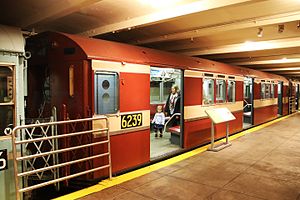R15 (New York City Subway car)
| R15 | |
|---|---|
 R15 car 6239 on display at the New York Transit Museum. | |
| In service | 1950-1984 |
| Manufacturer | American Car and Foundry |
| Constructed | 1950 |
| Number built | 100 |
| Number preserved | 1 |
| Number scrapped | 99 |
| Fleet numbers | 5953-5999, 6200-6252 |
| Capacity | 44 (seated) |
| Operators | New York City Transit Authority |
| Service(s) assigned | none |
| Specifications | |
| Car body construction | LAHT Carbon steel |
| Car length | 51 ft 0+1⁄2 in (15.56 m) |
| Width | 8 ft 10+3⁄16 in (2,697 mm) |
| Height | 11 ft 10 in (3,607 mm) |
| Floor height | 3 ft 9 in (1.14 m) |
| Doors | 6 |
| Maximum speed | 55 mph (89 km/h) |
| Weight | 74,778 lb (33,919 kg) |
| Power output | 100 hp (75 kW) per traction motor |
| Transmission | Westinghouse XM-179 or General Electric 17KC76A1 |
| Auxiliaries | 100 hp (75 kW) (4 per car) |
| Power supply | Westinghouse 1447C or General Electric 1240A3 |
| Electric system(s) | 600 V DC Third rail |
| Current collector(s) | Top running Contact shoe |
| Braking system(s) | WABCO Schedule SMEE with A-1 Application package, J1 relay valve, ME-42A brake stand, and A.S.F simplex unit cylinder clasp brake rigging |
| Coupling system | WABCO H2C |
| Track gauge | 4 ft 8+1⁄2 in (1,435 mm) |
The R15 was a New York City Subway car built in 1950 by the American Car and Foundry Company.
The R15s were numbered 5953-5999 & 6000-6252. The cars were the first to feature round "turtle-back" roofs and conductors' door operating apparatus controls located inside the motorman's cabs, instead of on the outsides as they were on the R12s and R14s. Additionally, the R15s featured porthole door windows, similar to those found on the R11s.[1]
While the R15s ran in solid consists on the Flushing line, the cars never did so on the mainlines; they were always intermixed in trains of newer cars.
Delivery of the cars began in January 1950, shortly after the last R14s were delivered.[2] The first R15s entered service on the 7 (IRT Flushing Line) on February 4, 1950.[3] All 100 cars delivered by January 1950.[4]
The R15s ran on the Flushing Line until the arrival of the R33WFs and R36WFs in late 1963-early 1964. The R15s were then transferred to operate on other A-division routes before being retired and replaced by the R62s in the mid 1980s. The last R15 ran on December 10, 1984. Except for one car, all cars have since been taken off property to be scrapped; several cars lasted as training vehicles or work cars for many years. For example, cars 5965, 5984-5985, 5989, and 6214 were converted into R71 rider cars after retirement, but were replaced with R161s (R33s converted into rider cars) and subsequently reefed in the mid-2000s.[5]
The only R15 car that remains today is 6239. The car has been preserved by the New York Transit Museum since 1976, and was restored. It has been operated on fantrips since 2004.
References
- ^ "www.nycsubway.org". www.nycsubway.org.
- ^ "IRT SMEE delivery dates", R36 Preservation, Inc. http://www.coronayard.com/r36preservation/irtsmeedelivery.htm
- ^ ERA New York Division Bulletin, September 2009, Page 4
- ^ ERA New York Division Bulletin, September 2009, Page 4
- ^ "www.nycsubway.org". www.nycsubway.org.
